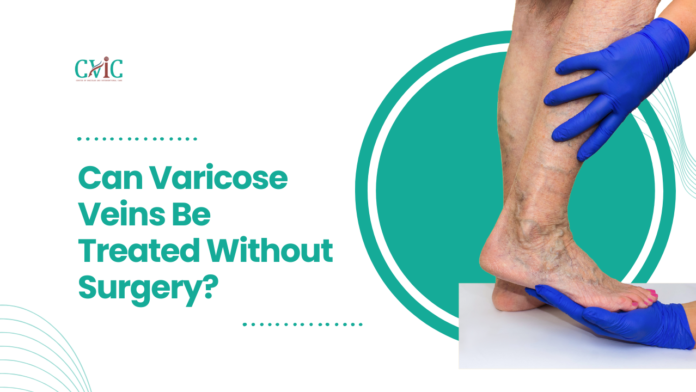Varicose veins can be more than just a cosmetic concern—they often come with pain, discomfort, and potential complications. While surgical options have been the traditional route for treatment, advancements in medical technology now offer several non-surgical alternatives. But can varicose veins be treated without surgery? Absolutely! In this blog, we will explore various non-surgical treatments that effectively address varicose veins, helping you achieve relief without going under the knife.
What Are Varicose Veins?
Varicose veins are swollen, twisted veins that usually appear on the legs. They are caused by weakened or damaged valves in the veins, which allow blood to pool and veins to become enlarged. Common symptoms include aching pain, heaviness, and a visible blue or purple appearance on the skin.
Why Consider Non-Surgical Treatments for Varicose Veins?
Surgical procedures like vein stripping or ligation have been effective but are invasive and often require significant recovery time. Non-surgical treatments offer several benefits, including:
- Minimal downtime
- Reduced risk of complications
- Less pain during and after the procedure
- No need for general anesthesia
These factors make non-surgical options appealing to those who want to treat varicose veins without the risks associated with surgery.
Also Read: Best Treatment for an Aneurysm: Key Options to Consider for Optimal Recovery

Top Non-Surgical Treatments for Varicose Veins
Sclerotherapy: A Minimally Invasive Solution
Sclerotherapy is a popular non-surgical treatment for varicose veins. It involves injecting a special solution directly into the affected veins, causing them to collapse and gradually fade away. This procedure is quick, relatively painless, and requires no anesthesia. Most patients can return to normal activities immediately, making it a convenient option.
How Does Sclerotherapy Work?
The solution irritates the lining of the vein, leading to the formation of scar tissue that seals off the vein.
Laser Therapy: Quick and Effective for Small Varicose Veins
Laser therapy is another non-surgical option that uses focused light to treat varicose veins. The heat from the laser damages the vein, causing it to close off and fade over time.
Benefits of Laser Therapy:
- No incisions or needles are required
- Minimal discomfort
- Quick recovery time
Laser therapy is especially effective for superficial varicose veins that are close to the surface of the skin.
Also Read: Newest Treatment for Varicose Veins: Innovations in Vascular Health

Endovenous Laser Treatment (EVLT): A Modern Approach
Endovenous Laser Treatment (EVLT) is a more advanced laser therapy that targets larger varicose veins. During this procedure, a thin laser fiber is inserted into the vein through a small incision. The laser heats the vein from the inside, causing it to collapse and seal shut.
Advantages of EVLT:
- High success rate
- Performed under local anesthesia
- Quick, with most procedures taking less than an hour
Radiofrequency Ablation (RFA): An Effective Alternative
Radiofrequency Ablation (RFA) is a technique that uses radiofrequency energy to heat and close off varicose veins. The heat from the radiofrequency energy damages the vein walls, leading to closure.
Why Choose RFA?
- Minimal pain and bruising
- Short recovery period
- High success rate for larger varicose veins
RFA is a safe and effective treatment, with many patients experiencing significant symptom relief.
Compression Therapy: A Conservative Approach
Compression stockings are often recommended as a first-line treatment for varicose veins, especially for mild cases. These specially designed stockings help improve blood circulation in the legs, reducing symptoms like swelling and discomfort.
Benefits of Compression Stockings:
- Non-invasive and affordable
- Helps prevent the progression of varicose veins
While compression therapy does not eliminate varicose veins, it can provide significant symptom relief and may be enough for those with mild cases.
Lifestyle Changes: Supporting Non-Surgical Treatments
In addition to the medical treatments mentioned above, lifestyle changes can play a vital role in managing varicose veins without surgery. Here are some tips to consider:
- Exercise regularly: Physical activity helps improve circulation and reduce pressure on veins.
- Maintain a healthy weight: Excess weight can put extra pressure on your veins, worsening symptoms.
- Elevate your legs: Elevating your legs helps reduce swelling and improve blood flow.
Incorporating these habits into your daily routine can complement non-surgical treatments and help prevent the progression of varicose .
Also Read: What is the Most Effective Treatment for Varicose Veins?
Are Non-Surgical Treatments Right for You?
The best treatment for veins depends on various factors, including the size and location of the veins, your symptoms, and your overall health. Consulting with a vein specialist can help you determine whether non-surgical options like sclerotherapy, laser therapy, EVLT, or RFA are appropriate for your condition.

FAQs
Can varicose be completely eliminated without surgery?
Yes, many non-surgical treatments like sclerotherapy and laser therapy can effectively reduce or eliminate veins.
How long does it take to recover from non-surgical varicose vein treatments?
Recovery time is usually short, with most patients resuming normal activities within a day or two.
Are non-surgical treatments for veins covered by insurance?
Coverage depends on the severity of your condition and your insurance plan.
What is the success rate of non-surgical varicose vein treatments?
Non-surgical treatments like EVLT and RFA have high success rates, often exceeding 90%.
Can I prevent veins from developing in the future?
While you cannot always prevent veins, maintaining a healthy lifestyle, exercising, and wearing compression stockings can reduce your risk.
Conclusion
With numerous non-surgical options available today, you can find relief without the need for invasive procedures. From sclerotherapy and laser therapy to lifestyle changes and compression therapy, there are many effective ways to manage and treat veins.
Remember, consulting with a medical professional is key to determining the best treatment plan for your unique needs. With the right approach, you can say goodbye to the pain and discomfort of veins and enjoy healthier, happier legs.




